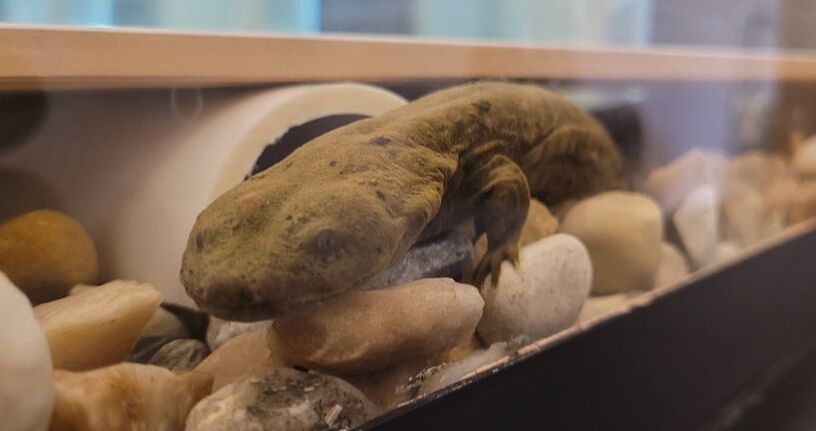|
Note: This is the second in a two-part package covering a recent hellbender release as part of a reintroduction pilot program. The first element, a feature story and photo gallery, can be accessed here. Surrounded by posters and other informational resources on a large wall of a rural New York laboratory, a homemade 3-inch-square framed cross-stitch suggests that hellbenders are simply “less furry kittens.” It is a simple metaphor suggesting a not-so-simple truth. Perhaps if hellbenders were furry and purred for attention, then maybe their dire situation as a species would garner more headlines, efforts for advocacy and the necessary changes to restore their habitat and save our state’s largest amphibian from impending doom. “In 15 years of studying the hellbender, we had one major population within the greater watershed disappear virtually before our eyes with really no understanding of why that happened,” said Dr. Peter Petokas, a research associate with the Clean Water Institute at Lycoming College, during an April interview on the Middle Susquehanna Riverkeeper Podcast. “And then another population was wiped out by a sodium hydroxide spill back in 2006 when a rail car overturned next to a tributary.” Petokas also estimated that 95 percent of the species’ habitat in the Susquehanna watershed no longer exists. Hellbenders require clean, cool water with large rock structures that aren’t impacted by excessive sedimentation/erosion issues. They also respirate directly through their skin, so they are highly susceptible to contaminants that enter the water. That vulnerability provides an important litmus test for water quality. “It’s sort of like the canary in the coal mine, but for water quality,” said Petokas during his podcast episode. “They prefer fairly large streams with clean water that have a stable food chain and an abundance of crayfish. They require waterways with large rocks – like rocks the size of cars – and those rocks must be kept clean. Fine sediment in the waterway can bury those rocks. Habitat is critical for this creature, and if it is present, it is an indicator of clean water conditions.” In addition, the Eastern hellbender is extremely unique. It is the largest amphibian within our country, ranging upwards of two feet in length – the next largest amphibian, the mudpuppy, is lucky to reach 10-12 inches. The hellbender is also significant because its closest living relatives are the world’s two largest salamander species – both found only in Asia. Despite all this, most people know very little about the species. Based on looks – and unfortunate nicknames such as snot otter, mud devil, Allegheny alligator and old lasagna sides – alone, rallying resources for a rescue effort may not seem like a priority. Hellbenders are blotchy brown in coloration, with some darker splotching scattered throughout. They look fairly flat and wide, partially due to the excess wrinkly skin along the sides that resembles the edges of lasagna noodles. While all of this helps camouflage the hellbender in its natural habitat along rocky waterway floors, the features don’t help its less-than-photogenic appearance. In a highly visual society where cute photos and videos on TV and the internet spark donations for panda or koala rescue efforts overseas – or more locally to those helping abused and abandoned kittens and puppies – the hellbender's situation goes mostly unnoticed. Fortunately, Petokas and his team of volunteers are working to reverse the species’ downward spiral. “I think they deserve – and have the right – to continue to exist,” he said recently as 124 juvenile hellbenders – raised in conjunction with the Bronx Zoo and a small lab in lower New York state – were released into a nearby stream that had been cultivated into the perfect hellbender habitat. On behalf of the Middle Susquehanna Riverkeeper Association, I was honored to be invited to participate in the process. The lab – located adjacent to a former golf course that has been recycled into a natural wetland oasis – featured rows of well-maintained tanks fitted with PVC pipe structures and stones that provided shelter that would mimic manmade hellbender huts and more natural features that the juvenile hellbenders would inhabit once released. As the hellbenders were processed for transport – each catalogued in a detailed log based on an RFID PIT tag that will help the team monitor survival and living patterns – I helped weigh each one by carefully placing it in a small bucket on a scale. Being able to handle such unique creatures was incredible – I immediately realized that these juvenile hellbenders were equal parts feisty and fragile. It was obvious how well-raised they were – showing considerable growth since their last weigh-ins, and they were really active. Smooth, somewhat slimy and strikingly delicate, it was impossible not to connect with their plight and want to do more to raise awareness and rouse assistance for such a well-organized, scientifically focused and groundbreaking pilot project that realistically could help reintroduce the species to other sections of the Susquehanna watershed if the right resources become available. Along those lines, the Middle Susquehanna Riverkeeper Association continues its efforts – in conjunction with the Center for Biological Diversity, Waterkeeper Alliance, Waterkeepers Chesapeake and Lower Susquehanna Riverkeeper Association – to push for enhanced protections for the Eastern hellbender via a threatened or endangered designation from the US Fish and Wildlife Service. We also will continue to help amplify educational efforts about the species via Petokas, his team and others who share a passion for the hellbender. He can be contacted via email at [email protected] You can follow along with all our hellbender-related stories, programs and efforts to fight for protections via a newly created hellbender page on our website: www.middlesusquehannariverkeeper.org/hellbenders1.html
0 Comments
Leave a Reply. |
AuthorsRiverkeeper John Zaktansky is an award-winning journalist and avid promoter of the outdoors who loves camping, kayaking, fishing and hunting with the family. Archives
July 2024
Topics |

 RSS Feed
RSS Feed